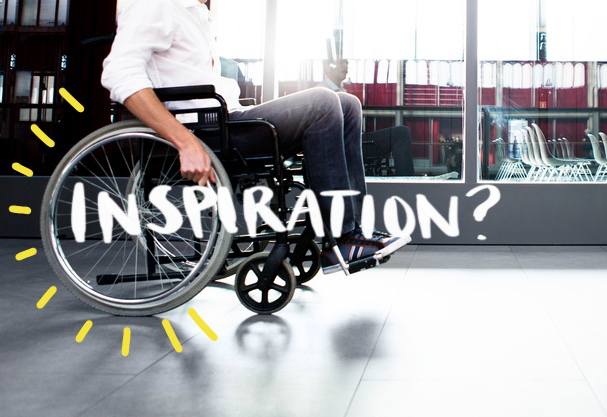 We’ve all seen people with disabilities in movies or commercials where the music and imagery make them seem either super human, brave or courageous. This usually follows themes such as: tragedy to triumph, some sort of athletic fete, or getting into the ‘in’ crowd. The word you’ve heard, and likely have said, is INSPIRATIONAL – the most over-used word to describe people with disabilities. We’ve all heard some variation of these messages: ‘People with disabilities are such an inspiration.’ Or, ‘When I see people like that, it makes me realize I have nothing to complain about.’ Many companies default to this type of messaging, which the disability community has categorized as “inspiration porn.” While well-intended, these types of portrayals can spark significant backlash from the disability community and its supporters.
We’ve all seen people with disabilities in movies or commercials where the music and imagery make them seem either super human, brave or courageous. This usually follows themes such as: tragedy to triumph, some sort of athletic fete, or getting into the ‘in’ crowd. The word you’ve heard, and likely have said, is INSPIRATIONAL – the most over-used word to describe people with disabilities. We’ve all heard some variation of these messages: ‘People with disabilities are such an inspiration.’ Or, ‘When I see people like that, it makes me realize I have nothing to complain about.’ Many companies default to this type of messaging, which the disability community has categorized as “inspiration porn.” While well-intended, these types of portrayals can spark significant backlash from the disability community and its supporters.
So, what is ‘inspiration porn?’
Inspiration porn is used to describe society’s tendency to reduce people with disabilities down to objects of inspiration. This is most often displayed through images, videos, or feel-good articles that sensationalize people with disabilities.
Where did this idea come from?
The concept of “inspiration porn” emerged around 2012 from an editorial and subsequent TEDx Talk by late disability rights activist, writer, and comedian, Stella Young. Young’s 2014 Ted Talk, entitled, “I’m Not Your Inspiration, Thank You Very Much,” focused on popular social media memes of people with disabilities, with captions like, “Before you quit, try!” and “The only disability in life is a bad attitude.” More often than not, these images include people with disabilities doing everyday activities, like coloring or rolling down the street in a wheelchair. “These images…are what we call ‘inspiration porn,’” shared Young. “And I use the term ‘porn’ deliberately, because they objectify one group of people for the benefit of another group of people. In this case, we’re objectifying disabled people for the benefit of nondisabled people.” Although these images are designed to motivate and inspire able-bodied people, as Young explained, they are degrading to people with disabilities. The goal is for people without disabilities to think, “Wow! I thought I had it bad, but it definitely could be worse.”
How can you identify ‘inspiration porn?’
When it comes to identifying whether an image, video, or text could be considered inspiration porn, look for these characteristics:
- People with disabilities are objectified – In inspiration porn, people with disabilities are not represented as people, but as objects. Captions such as, “What’s your excuse?” or “Your excuse is invalid,” use people with disabilities as tools to guilt able-bodied people into doing or achieving more.
- People with disabilities are devalued – In inspiration porn, people with disabilities are generally praised for commonplace activities (like getting dressed or sitting at the beach). This makes it seem like people with disabilities are not capable of the same level of achievements as their able-bodied peers, or that able-bodied people should be doing a lot more (e.g. “If they can do it, I have no excuse!) Also, it implies that disabled lives aren’t worth living. Statements like, “You’re so brave. I don’t know how you do it,” send the idea that people with disabilities have it so bad that simply existing is an achievement.
- People with disabilities are depicted as the “problem” – Inspiration porn focuses on portraying visible disabilities as problems that need to be overcome. This overlooks the idea that people with disabilities encounter access barriers, both physical and attitudinal, that are really the true problems.
- Able-bodied people are portrayed as heroes for simple, human acts – You’ve likely seen images or heard stories about “heroic prom-posals,” where able-bodied teens ask their peers with physical or intellectual disabilities to prom. One picture even shows a boy offering a corsage to a wheelchair user as he asks her to prom, with a caption that reads, “He asked her to prom in her condition. Like and Share = Respect.” Many media stories and images praise able-bodied people for doing things for people with disabilities that really should not be considered heroic or special. Other stories have gone viral that include able-bodied students “giving up” their homecoming court titles for their disabled peers, or people in restaurants helping wheelchair users access their food. None of these acts should be considered heroic. They should be considered human.
Can people with disabilities be considered inspirational?
Categorizing some disability-focused messaging as inspiration porn doesn’t mean that people with disabilities can’t and don’t do inspiring things every day. People with disabilities are starting their own businesses, completing high levels of education, winning significant sporting events, fighting on the front lines for their rights and those of others, and so much more. The problem with inspiration porn’s messaging is that the inspiration is watered down merely to a person having a disability. That, in itself, should not be considered the source of inspiration.
Could your message be perceived as inspiration porn?
If you’re trying to figure out if an image, video, or other media message could come across as inspiration porn, simply ask these questions…
For an image of a person with a disability:
- If a person with a disability was not doing this activity, would it still be inspiring? If an able-bodied person were completing this task, would it still be considered brave or courageous?
For an image of an able-bodied person interacting with a person with a disability:
- If two able-bodied people were having this interaction, would this be considered extraordinary? Would it be “heroic” or special?
If your answer is no to any of these questions, then don’t share it. Rework your angle. Instead, focus on the truly extraordinary achievements of people of all abilities.
 Ideally, the journey people with disabilities take to become loyal customers would be a straight, short route: See the product. Check for Accessibility Features. Buy your product. Use your product. Tell Friends. Repeat.
Ideally, the journey people with disabilities take to become loyal customers would be a straight, short route: See the product. Check for Accessibility Features. Buy your product. Use your product. Tell Friends. Repeat. Companies that successfully reach consumers with disabilities understand it requires commitment, discipline and strategy. The truth is there’s such a barren landscape of companies speaking to them directly, that any company serious about penetrating the market has the opportunity to make the competition irrelevant. These disability inclusive companies know that moving beyond understanding to market penetration requires a well-developed game plan. A few things to consider as your organization takes actionable steps to engage people with disabilities, their families, and influencers are:
Companies that successfully reach consumers with disabilities understand it requires commitment, discipline and strategy. The truth is there’s such a barren landscape of companies speaking to them directly, that any company serious about penetrating the market has the opportunity to make the competition irrelevant. These disability inclusive companies know that moving beyond understanding to market penetration requires a well-developed game plan. A few things to consider as your organization takes actionable steps to engage people with disabilities, their families, and influencers are: A rule of business is to create products, experiences and/or services needed by customers so they buy it, share it, and buy it again. If customers aren’t buying what you’re selling, your business is a hobby. For instance, coffee by itself is just a caffeinated, warm beverage, but Starbucks has created an experience for its customers. Howard Schultz, company President and CEO, defined the atmosphere that Starbucks attempts to create when he said “We’re in the business of human connection and humanity, creating communities in a third place between home and work.”
A rule of business is to create products, experiences and/or services needed by customers so they buy it, share it, and buy it again. If customers aren’t buying what you’re selling, your business is a hobby. For instance, coffee by itself is just a caffeinated, warm beverage, but Starbucks has created an experience for its customers. Howard Schultz, company President and CEO, defined the atmosphere that Starbucks attempts to create when he said “We’re in the business of human connection and humanity, creating communities in a third place between home and work.”